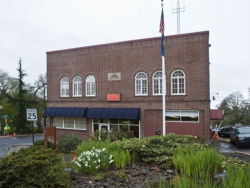Needs Assessment
The existing West Linn police station was constructed in 1936. The City owns the footprint of this building but not the surrounding land or parking lot thus, there is no parking and no room to expand on the existing site. The City contracted with architects from Group Mackenzie to provide professional services to evaluate the existing facility and determine future needs for a new facility that would allow thirty-year growth for the department. The needs assessment was devloped after significant stakeholder involvement, and completed in 2010. An updated site selection due dilligence report was provided to City Council in 2011 by Group Mackenzie in an executive session, and includes site analysis for the property the City subsequently acquired for the new facility.
The proposal for the new police station will have approximately 23,500 sq. ft. and will be built to meet today’s needs and the projected needs through 2042. The current police force includes 31 sworn officers and five support staff, and is expected to grow with the city’s population through 2042.
The new facility and site will accomplish many things that the existing facility does not. Most importantly, it will be designed to withstand a seismic design category D earthquake and to provide emergency dispatch and operations capability, if the regional dispatch that is currently used is not available. The current police parking lot is not owned by the City; however the new site will provide secure parking for police vehicles in order to better accommodate the public. It will also provide for onsite storm-waste storage and cleansing. The building will be constructed to the Silver LEED standard by incorporating sustainable features in its construction and operation.
The new structure will better accommodate training, evidence processing, storage, operations, communication and staffing needs for men, women and K9 units providing police services. Citizen needs will also be met by providing public parking and space for public reception and interaction.

